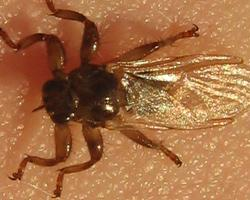
Popis zvířete
The deer ked, scientifically known as Lipoptena cervi, is a species of biting fly within the family Hippoboscidae, commonly referred to as louse flies. This parasitic insect has garnered attention for its unique life cycle and its relationship with deer, its primary host, although it can occasionally target other mammals, including humans.Adult deer keds are small, typically measuring between 4 to 7 millimeters in length. They possess a somewhat flattened body, an adaptation that aids in their life among the dense fur of their hosts. Their coloration ranges from dark brown to a reddish-brown, allowing them to blend seamlessly into the fur of their hosts for camouflage. One of the most striking features of the deer ked is its winged state upon reaching adulthood, which it eventually loses after finding a suitable host. The wings are shed by the adult ked as it burrows into the host's fur, a unique adaptation that signifies its transition to a parasitic lifestyle.
The life cycle of the deer ked is fascinating, beginning with the female laying a single, large larva at a time. This larva immediately pupates upon being deposited by the female. The entire process from larva to adult can take several months, with the newly emerged adult ked then seeking a host to feed on. Their diet consists exclusively of the blood of their hosts, which they obtain through their piercing mouthparts designed to penetrate the skin.
Deer keds are highly adapted to their parasitic lifestyle. Their legs are equipped with strong claws, enabling them to cling to the fur of their hosts despite any attempts by the host to dislodge them. This tenacity, combined with their flat body shape, makes them adept at navigating through the fur and avoiding grooming activities of the host.
While deer are the primary hosts for the deer ked, these parasites can occasionally find their way onto other mammals, including horses, cattle, and even humans. In such cases, they can cause irritation and discomfort, leading to dermatitis or allergic reactions in sensitive individuals. However, it's important to note that deer keds do not typically thrive on non-deer hosts and are not known to transmit any diseases to humans.
In their natural habitats, which include forested areas where deer populations thrive, deer keds play a role in the ecosystem. They are a part of the complex food web, acting as both parasites to their hosts and as prey to other animals. Birds, for example, may prey on the larvae or pupae of deer keds, thus controlling their populations to some extent.
In conclusion, the deer ked (Lipoptena cervi) is a unique parasitic insect with a specialized lifestyle that closely ties it to deer and other large mammals. Its adaptation to a parasitic life, including the loss of wings upon finding a host and its ability to navigate and remain undetected in the fur, highlights the complex interactions between parasites and their hosts. While generally not a threat to human health, their presence can cause concern among hunters, wildlife enthusiasts, and anyone engaged in outdoor activities in regions where these insects are prevalent.
Nové fotografie zvířat
Top 10 zvířat
- Dolphin gull (Leucophaeus scoresbii)
- Diana monkey (Cercopithecus diana)
- Moustached guenon (Cercopithecus cephus)
- Galápagos tortoise (Geochelone nigra complex)
- Stone loach (Barbatula barbatula)
- Japanese macaque (Macaca fuscata)
- Russian tortoise (Testudo horsfieldii)
- Greek tortoise (Testudo graeca)
- Common flying dragon (Draco volans)
- Vendace (Coregonus albula)